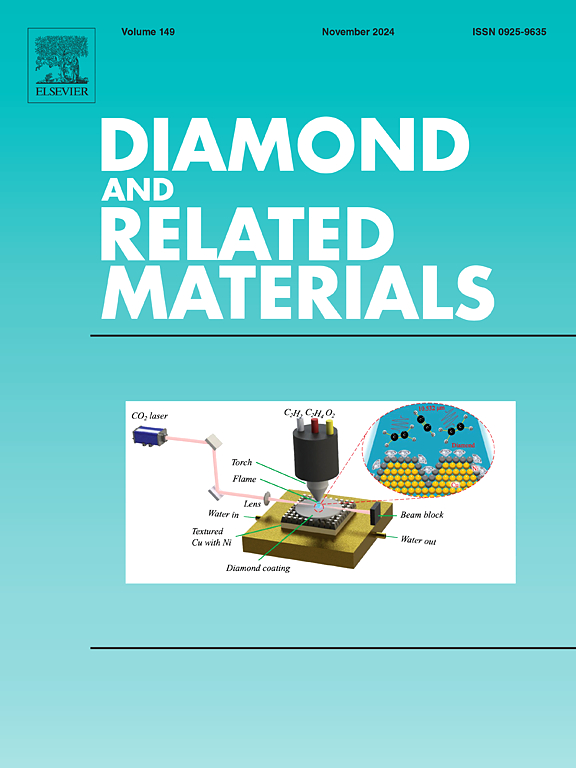Anti-bunching behavior of photons and strain determination in boron-implanted single-crystal diamond using irradiation induced nitrogen-vacancies
IF 4.3
3区 材料科学
Q2 MATERIALS SCIENCE, COATINGS & FILMS
引用次数: 0
Abstract
The work reports on irradiation-induced negatively-charged nitrogen-vacancy () centres generation in single-crystal diamonds through boron ion-implantation (energy 130 keV), followed by subsequent annealing. Ion-implantation generates significant lattice defects, such as vacancies, which bind to substitutional nitrogen atoms to form centres during post-irradiation annealing process. The irradiation-induced centres were employed to determine the local strain and study the anti-bunching behavior of photons emitted from it. Single photon emission measurements exhibit the anti-bunching behavior of photons due to the presence of two- and three-color centres in the sample irradiated at fluence 1⨯1014 ions/cm2. However, samples irradiated at fluences (5⨯1014 and 1⨯1015 ions/cm2) depict the presence of three- and four-color centres. At the same time, irradiation induces strain in the crystal, which affects the energy level of centres. The spin states have been probed by optically detected magnetic resonance (ODMR), demonstrate the increase of local strain with rise in irradiation fluence. The resulting strain caused by irradiation is dominated by transverse strain compared to axial strain along the centre. The ODMR results are consistent with strain estimated from Raman and X-ray diffraction analysis of irradiated diamond samples. Our results open the route for potential applications of irradiation-induced centres in stain imaging, sensing, and quantum information processing devices.

利用辐照诱导氮空位测定硼注入单晶金刚石中光子的反聚束行为和应变
本文报道了通过硼离子注入(能量130kev)在单晶金刚石中产生负电荷氮空位(NV -)中心,然后进行退火。离子注入会产生明显的晶格缺陷,如空位,在辐照后退火过程中,空位与取代的氮原子结合形成NV -中心。利用辐照诱导的NV -中心测定了其局部应变,并研究了其发射的光子的反聚束行为。单光子发射测量显示出光子的反聚束行为,这是由于在辐照量为1的样品中存在双色中心和三色中心。然而,在影响(5 1014和1 1015离子/平方厘米)下辐照的样品显示了三色中心和四色中心的存在。同时,辐照引起晶体应变,影响了NV−中心的能级。用光学探测磁共振(ODMR)对NV−自旋态进行了探测,发现局部应变随辐照量的增加而增加。与沿NV -中心的轴向应变相比,辐照引起的应变主要是横向应变。ODMR结果与辐照金刚石样品的拉曼和x射线衍射分析估计的应变一致。我们的研究结果为辐照诱导的NV -中心在染色成像、传感和量子信息处理设备中的潜在应用开辟了道路。
本文章由计算机程序翻译,如有差异,请以英文原文为准。
求助全文
约1分钟内获得全文
求助全文
来源期刊

Diamond and Related Materials
工程技术-材料科学:综合
CiteScore
6.00
自引率
14.60%
发文量
702
审稿时长
2.1 months
期刊介绍:
DRM is a leading international journal that publishes new fundamental and applied research on all forms of diamond, the integration of diamond with other advanced materials and development of technologies exploiting diamond. The synthesis, characterization and processing of single crystal diamond, polycrystalline films, nanodiamond powders and heterostructures with other advanced materials are encouraged topics for technical and review articles. In addition to diamond, the journal publishes manuscripts on the synthesis, characterization and application of other related materials including diamond-like carbons, carbon nanotubes, graphene, and boron and carbon nitrides. Articles are sought on the chemical functionalization of diamond and related materials as well as their use in electrochemistry, energy storage and conversion, chemical and biological sensing, imaging, thermal management, photonic and quantum applications, electron emission and electronic devices.
The International Conference on Diamond and Carbon Materials has evolved into the largest and most well attended forum in the field of diamond, providing a forum to showcase the latest results in the science and technology of diamond and other carbon materials such as carbon nanotubes, graphene, and diamond-like carbon. Run annually in association with Diamond and Related Materials the conference provides junior and established researchers the opportunity to exchange the latest results ranging from fundamental physical and chemical concepts to applied research focusing on the next generation carbon-based devices.
 求助内容:
求助内容: 应助结果提醒方式:
应助结果提醒方式:


